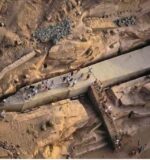This unfinished obelisk would have been the largest (known) ancient obelisk in the world if ever completed.

The city of Aswan, in Egypt, holds an ancient relic from thousands of years ago. A rare unfinished obelisk can be found at the Northern Quarries of the city. This piece of history can give us an insight into the incredible stone-working techniques and engineering of ancient Egypt.
The obelisk was directly carved out of the bedrock; however, due to the fact that it was never finished, the bottom side of the obelisk is still attached to the bedrock. The site of the quarry, which is in really good condition, is now an open museum and is protected by the Egyptian government in order to preserve these archaeological treasures.

Archaeologists believe that the construction of the monument was ordered by the female pharaoh Hatshepsut, “Foremost of Noble Ladies”. She became the ruler of the country sometime between 1512–1458 BC, during the 18th dynasty. Therefore, the Unfinished Obelisk is around 3500 years old.
These tall, four-sided monoliths, which end in a pyramid-like shape, were actually called tekhenu by the Egyptians. The word obelisk, as we know it today, was used by the Greeks and was later passed into English. Obelisks were a very important part of religious architecture in ancient Egypt and were usually placed in front of temples, as they symbolized the Sun God, Ra.
Interestingly, when the Roman Empire conquered Egypt, they became very fond of their obelisks. So much so, that they seized and shipped out obelisks from Egypt to various parts of the Empire. As a result, today more obelisks can be found outside of Egypt than inside. 13 of them reside in Rome – including the tallest Egyptian obelisk, the Lateran Obelisk, with its 105,6 feet (32,2 meters) and 502 tons.

The Unfinished Obelisk would be almost one-third larger than any other Egyptian-made obelisk. Had its creators finish it, it would have had a height of 137 feet (41,75 meters) and a weight of 1200 tons, which roughly equals the weight of 6 blue whales, the world’s largest creature.
The reason why they never finished this enormous piece is probably because of a wide crack that appeared on the slab as it was being separated from the bedrock, so they they just left it there. However, this gives us more insight into how these ancient giants were made.
Even though people may think that obelisks were built more easily than pyramids, constructing these monuments required very precise planning and craftsmanship, and involved many difficulties. They were usually made from pink granite, a stone with a strong internal structure that can support its own weight. Carving the base of the obelisk from a single bedrock was a common practice. Then, Egyptians were pounding its surface with Dolerite balls until it was smooth enough. Dolerite is suitable for shaping granite because it’s harder than granite, so it wouldn’t break in the process. Archaeologists found some of these balls at the site, and in fact, they can be seen to this day.

Repeatedly pounding against the surface of the stone was an exhausting job, though. It’s likely that it was a task done by prisoners, after professional stonemasons marked the site for construction.
Once the construct was ready to be separated from the bedrock, workers carved small cavities in the stone and filled them with wood. Then, these wooden wedges were repeatedly soaked in water, and the expansion of the wood caused the obelisk to break free from the bedrock.
When the obelisk was ready to be transported to its place, they used logs as rollers and pulled the obelisk with ropes. Then, a two-sided ramp had to be built next to the spot where they wanted the monolith to stand at, in order for the obelisk to be raised. They put the obelisk on its side next to the base of the ramp. Next, they tied ropes to the top and pulled it up until the obelisk would stand in a straight line.

Anyone who visits the Aswan Quarries and the Unfinished Obelisk can gain a detailed insight into an old world, of which we can only see small traces today.








 Photographer Finds Locations Of 1960s Postcards To See How They Look Today, And The Difference Is Unbelievable
Photographer Finds Locations Of 1960s Postcards To See How They Look Today, And The Difference Is Unbelievable  Hij zet 3 IKEA kastjes tegen elkaar aan en maakt dit voor zijn vrouw…Wat een gaaf resultaat!!
Hij zet 3 IKEA kastjes tegen elkaar aan en maakt dit voor zijn vrouw…Wat een gaaf resultaat!!  Scientists Discover 512-Year-Old Shark, Which Would Be The Oldest Living Vertebrate On The Planet
Scientists Discover 512-Year-Old Shark, Which Would Be The Oldest Living Vertebrate On The Planet  Hus til salg er kun 22 kvadratmeter – men vent til du ser det indvendigt
Hus til salg er kun 22 kvadratmeter – men vent til du ser det indvendigt  Superknepet – så blir snuskiga ugnsformen som ny igen!
Superknepet – så blir snuskiga ugnsformen som ny igen!  Meteorite That Recently Fell in Somalia Turns Out to Contain Two Minerals Never Before Seen on Earth
Meteorite That Recently Fell in Somalia Turns Out to Contain Two Minerals Never Before Seen on Earth  Nearly Frozen Waves Captured On Camera By Nantucket Photographer
Nearly Frozen Waves Captured On Camera By Nantucket Photographer  It’s Official: Astronomers Have Discovered another Earth
It’s Official: Astronomers Have Discovered another Earth 
9zkmbm
h1pr93
mzxygk